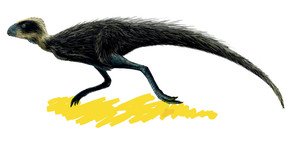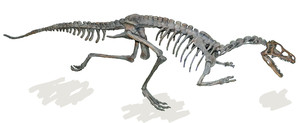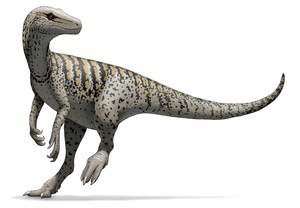 LadyofHats / Wikimedia CommonsIn a scientific paper featured on the cover of the March 22, 2017 issue of the scientific journal Nature, doctoral student Matthew Baron and his two advisors, David Norman of the University of Cambridge and Paul Barrett of the Natural History Museum in London, presented a new and controversial phylogenetic classification that changes the relationships and degree of kinship among the principal dinosaur lineages. The proposal refutes the validity of the classic separation of these reptiles into two major groups based on pelvis structure and argues for the adoption of different anatomical parameters for establishing the degree of proximity between the different types of dinosaurs. If it is proven and is adopted by other paleontologists, this alternative arrangement will profoundly alter the genealogical tree—or cladogram in the language of taxonomists—that has been in development since the late 19th century to encompass dinosaurs of different sizes, ecological habits and physical characteristics. “We knew that, if the proposal is correct, it would be a major paradigm shift and would have significant implications in our field. Consequently, we spent a lot of time testing the results, exploring and checking our data in search of errors before we published anything,” explains Baron, first author of the study.
LadyofHats / Wikimedia CommonsIn a scientific paper featured on the cover of the March 22, 2017 issue of the scientific journal Nature, doctoral student Matthew Baron and his two advisors, David Norman of the University of Cambridge and Paul Barrett of the Natural History Museum in London, presented a new and controversial phylogenetic classification that changes the relationships and degree of kinship among the principal dinosaur lineages. The proposal refutes the validity of the classic separation of these reptiles into two major groups based on pelvis structure and argues for the adoption of different anatomical parameters for establishing the degree of proximity between the different types of dinosaurs. If it is proven and is adopted by other paleontologists, this alternative arrangement will profoundly alter the genealogical tree—or cladogram in the language of taxonomists—that has been in development since the late 19th century to encompass dinosaurs of different sizes, ecological habits and physical characteristics. “We knew that, if the proposal is correct, it would be a major paradigm shift and would have significant implications in our field. Consequently, we spent a lot of time testing the results, exploring and checking our data in search of errors before we published anything,” explains Baron, first author of the study.
In 1887, British paleontologist Harry Seeley established a fundamental division that, with a few modifications and adjustments, endures to this day, guiding the work involved in the genealogical classification of dinosaurs. According to that division, there are two major types or branches of dinosaurs: Ornithischia, which have a pelvis similar to that of birds, and Saurischia, with a pelvis resembling that of lizards (see chart on page 43). Members of the first group are dinosaurs with horns (such as Triceratops), armor (such as Stegosaurus) and beaks similar to those of ducks. They could have been bipedal or quadrupedal, and most were herbivores. The Saurischia comprise two subgroups: theropods—bipedal carnivores such as Tyrannosaurus and Velociraptor; and sauropods, generally large herbivorous quadrupeds with an elongated neck, such as Diplodocus and Brachiosaurus.

Michael B. H / Wikimedia Commons
Reconstruction of Ornithischia Pisanosaurus mertii…Michael B. H / Wikimedia CommonsThese are three oldest basal lineages, creatures that originated about 230 million years ago during the Middle Triassic Epoch and from which most of the known species of dinosaurs descended. There is yet a fourth dinosaur typology, discovered in the 1960s in Argentina and subsequently in Brazil: small carnivores from the group known as Herrerasauridae. They are probably older than the members of the other three lineages, but their classification is historically problematic. There are only half a dozen known species, such as Herrerasaurus ischigualastensis and Sanjuansaurus gordilloi in Argentina and Staurikosaurus pricei in Brazil. Depending on the author, they are considered theropods, sauropods or even as species outside the dinosaur tree. The current fossil record indicates that the Herrerasaurus lineage lasted for around 30 million years and left no descendants.
The alternative genealogy proposed by Baron, Norman and Barrett argues for abolishing the Ornithischia-Saurischia dichotomy and rearranging the basal lineages into two new central branches. The name Saurischia would be preserved, but the group would lose the theropods and would consist of sauropods and herrerasaurids. Ornithischia and theropods would share 21 common anatomical traits and would constitute the two lineages of a new group called Ornithoscelida. Judging from the uproar among paleontologists who are unconvinced of the soundness of the new classification, the proposal will have to overcome skepticism and scientific scrutiny on the part of their peers. “It’s not a question of disputing the method they used in their work, which is the same method we all use in this field; it’s the quality of the data they used,” comments Max Langer, a paleontologist at the University of São Paulo, Ribeirão Preto campus, an expert in dinosaur origins and diversification. “Wrong data lead to wrong results. An exceptional result like theirs must be supported by exceptional evidence.”

The Lord of the Allosaurs/Wikimedia Commons
…and skeleton of theropod Eoraptor lunensis. Both are dinosaurs of the group Ornithoscelida, according to the new classificationThe Lord of the Allosaurs/Wikimedia CommonsLanger and nine other paleontologists from various parts of the world are reexamining the data published in the British authors’ study and looking for errors. Baron asserts that the data have been reviewed several times. “There might be one or two errors in the entire dataset, which is almost unavoidable, and some of our interpretations could be questioned,” he counters. “As people become more familiar with our work, they’ll realize that it’s not an error, and that there is a scientific discussion to be undertaken.”
The Cambridge/London Natural History Museum-based group analyzed 457 anatomical traits of 74 species of dinosaurs and reptiles that lived shortly before the emergence of the dinosaurs. That mountain of data generated a matrix of nearly 34,000 data points. “In the past, paleontologists used to do manual anatomical comparisons between species,” Langer says. “Today, especially when we work with a large number of traits and species, we use computer programs to perform that task.” Software programs such as TNT, which the British group used, or PAUP, assemble species into groups with shared anatomical traits, suggest which species appeared before others, and lastly, provide genealogical trees based on a data matrix.
 Each anatomical trait of each species is converted to a numerical code, which can assume one of two values, a 0 or a 1, depending on its meaning. For example, in the study by Baron and his colleagues, the presence of premaxillary teeth—trait number 150 on the authors’ list—is 0, and the absence of such teeth is a 1. If there is uncertainty about the characteristics of an anatomical trait in a species, it can be coded as a question mark (?). If the trait does not apply to a species, it is represented by a dash (−). “The software calculates the smallest possible number of evolutionary steps necessary for a more basal species to give rise to another, with derived traits,” Langer explains.
Each anatomical trait of each species is converted to a numerical code, which can assume one of two values, a 0 or a 1, depending on its meaning. For example, in the study by Baron and his colleagues, the presence of premaxillary teeth—trait number 150 on the authors’ list—is 0, and the absence of such teeth is a 1. If there is uncertainty about the characteristics of an anatomical trait in a species, it can be coded as a question mark (?). If the trait does not apply to a species, it is represented by a dash (−). “The software calculates the smallest possible number of evolutionary steps necessary for a more basal species to give rise to another, with derived traits,” Langer explains.
Much of the knowledge produced on dinosaurs—almost mythical creatures that lived on Earth between approximately 230 million and 66 million years ago—will probably have to be rewritten or amended if Baron’s hypotheses stand. Where and when did the dinosaurs emerge? Did carnivorism appear once or twice? These questions have always been more or less controversial, but they were being studied within an evolutionary context anchored in a genealogical tree of dinosaurs that, while not perfect, has been accepted for more than 130 years. The new classification significantly alters that scenario and necessitates a review of heretofore widely circulated hypotheses.
 Origins
Origins
Most paleontologists today, for example, support the idea that the dinosaurs emerged in the Southern Hemisphere, given the fact that the oldest fossils—nearly 230 million years old—have been found in Argentina, Brazil and Tanzania. According to the new classification, they could have originated anywhere in the world, perhaps even in the Northern Hemisphere. After all, according to the phylogeny presented by the Cambridge group, the non-dinosaur reptile anatomically closest to the earliest groups of dinosaurs is Saltopus elginensis, a carnivorous biped 60 centimeters tall that lived approximately 240 million years ago in what is now Scotland. The authors of the newly proposed genealogical classification also argue that the first dinosaurs were omnivores that ate both plants and animals, and imply that carnivorism arose twice, and independently, in herrerasaurs and theropods. The current dominant view suggests that the practice of eating meat appeared only once and was already present in the first dinosaurs.

Fred Wierum/Wikimedia Commons
Paleontologists have trouble classifying the small carnivores Herrerasaurus ischigualastensis…Fred Wierum/Wikimedia CommonsThe British trio’s paper agrees with recent phylogenetic studies on at least one point. Like other studies, it proposes that the first dinosaurs were small bipeds two meters in length whose upper limbs were free to grasp their prey. “We can’t turn disagreements into a debate as if it were a soccer game,” says Fernando Novas, a paleontologist at the Bernardino Rivadavia Natural Science Museum in Buenos Aires, one of the most renowned specialists and discoverers of dinosaurs working today. “I don’t know whether Baron’s hypothesis is right or wrong. Evolution is a complex thing. All paleontologists engage in some kind of speculation.” Nevertheless, he found it strange that the study in Nature included fossil data from two species viewed as being pre-dinosaurs—S. elginensis and Agnosphytis cromhallensis—which lived about 240 million years ago. “Those bones are poorly preserved. I wouldn’t use them,” Novas says.
In the opinion of Sterling Nesbitt, a paleontologist at Virginia Tech in the United States who is an expert on the first dinosaurs and their predecessors, it makes little sense to debate whether the dinosaurs emerged above or below the Equator. “The present-day continents were part of Pangaea when the dinosaurs emerged,” Nesbitt explains. Pangaea was the name given to an ancient supercontinent consisting of two large connected landmasses: Laurasia, which included North America, Europe and Asia, and Gondwana, which encompassed most of South America, Africa, Antarctica and Madagascar. Laurasia and Gondwana separated approximately 200 million years ago, well after the first dinosaurs appeared. An April 2017 study by Nesbit, which also appeared in Nature, described a possible ancestor of the dinosaurs, Teleocrater rhadinos, a reptile with the body of a crocodile, an exceptionally long tail and neck, and a few bones typical of a dinosaur. The species lived 245 million years ago in what is now Tanzania.

Felipe Alves Elias/O guia completo dos dinossauros do Brasil
…and Staurikosaurus pricei under the current modelFelipe Alves Elias/O guia completo dos dinossauros do BrasilNo DNA
To prepare their cladograms, paleontologists cannot rely on DNA samples, the tool used today in several fields of biology to conduct phylogenetic studies. As a result, those who specialize in these reptiles are forced to base their studies solely on examination of the anatomical specificities of the fossilized bones and teeth recovered in excavations. In this case, better-preserved samples are more informative than fragmented remains. The degree of kinship and proximity of species are determined by the number and evolutionary importance of the traits present in the samples being analyzed. Thus, some traits are considered more basal, that is, older and more primitive, because they emerged in a common ancestor and were maintained in species of that lineage. Others are interpreted as derived traits that were not present in the common ancestor and appear later in only some members of the lineage. “Paleontologists work with morphological data and make comparisons,” Novas explains. “We’re looking for evolutionary novelties, previously unknown anatomical traits.”
One of the major challenges for paleontologists is establishing whether the identification of a new evolutionary trait common to two different lineages means that the two are related and shared a common ancestor at some point in their history, or whether it means that the emergence of this structure occurred independently in the two cases. Birds and bats, which are placental mammals, have wings that enable them to fly. But we know that the wings in these two groups exhibit different anatomical structures, and that birds and bats do not share the same evolutionary history. Such independent emergence of structures with similar functions (flying) is called convergent evolution. In the case of traits that appear in more than one of the four basal lineages of dinosaurs, that distinction is usually problematic. “Sometimes we also find ourselves at an impasse: the bones of the head tell us one evolutionary story, and the bones of the tail tell a different one,” comments Alex Kellner, a paleontologist at the National Museum of Brazil (MN-UFRJ) who specializes in pterosaurs, extinct winged reptiles that emerged shortly before the dinosaurs.

Mark Witton / Natural History Museum, London
About 240 million years ago, when the pre-dinosaur Teleocrater rhadinus lived, the blocks of land on Earth were joined in the supercontinent PangaeaMark Witton / Natural History Museum, LondonAccording to Kellner, who on occasion studies dinosaurs as well, new proposals for taxonomic classification need to be viewed with caution and must withstand scrutiny by other scientists. He recalls the confusion recently caused by erroneous interpretations circulated by David Peters, a paleoartist and amateur paleontologist, who maintains websites and has published books and articles on pterosaurs. In addition to supporting the never-proven idea that there were vampire pterosaurs that fed on blood, in the past decade Peters even proposed a new genealogical tree for these flying reptiles, but it did not take hold. The discussions around the paper in Nature proposing a new classification of dinosaurs are occurring, as they will in the future, on a different level. The paper was written by paleontologists from renowned British institutions. “If no errors are found in the way in which the authors coded the dinosaurs’ anatomical traits, the proposal might stand. Those are the rules of the game,” Kellner opines. “If there are errors, science will correct them.”
Project
The origin and rise of dinosaurs in Gondwana (late Triassic – early Jurassic) (No. 14/03825-3); Principal Investigator Max Langer (USP); Grant Mechanism Thematic Project; Investment R$1,959,890.17.
Scientific article
BARON, M. G., NORMAN, D. B. and BARRETT, P. M. A new hypothesis of dinosaur relationships and early dinosaur evolution. Nature. March 22, 2017.